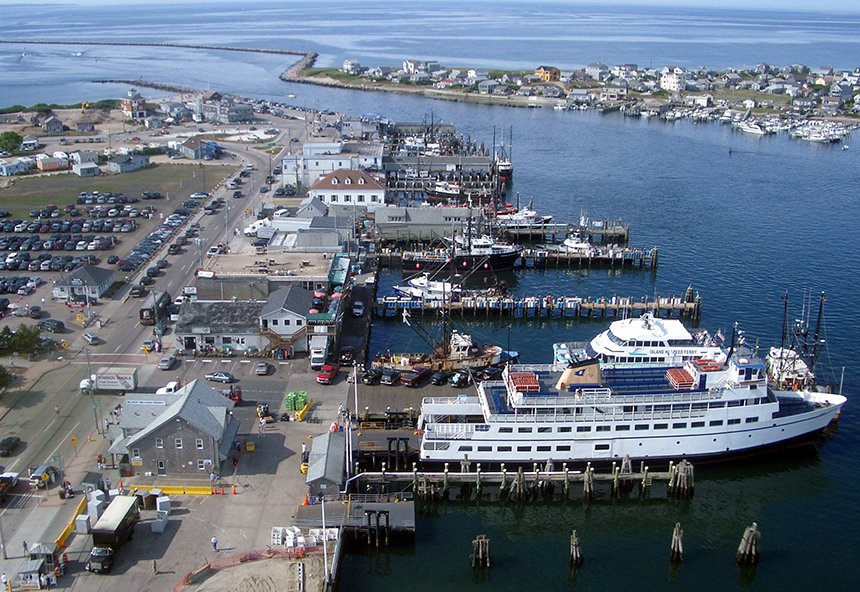Port of Galilee Upgrades Part of DEM Budget Proposal
By ROB SMITH/ecoRI News staff

With sea levels expected to rise another 1-4 feet over the next century, the proposal would extend the life of the popular fishing port ‘by decades.’ (Town of Narragansett)
State officials have proposed investing $46 million in Narragansett’s Port of Galilee to modernize and upgrade the port.
At least half the money would go toward raising bulkheads — steel
barriers between the land and the sea — by 18 inches to protect against
sea-level rise.
Gov. Daniel McKee’s fiscal 2023 budget proposal would raise the
Rhode Island Department of Environmental Management’s operating budget from
$95 million to $105 million, with another $17 million set aside for capital
projects. McKee’s total budget proposal
calls for $12.8 billion in spending during fiscal 2023, which begins July 1,
with $5.3 billion of that amount federally funded.
Rhode Islanders know it as the place to sail away on the Block Island Ferry, but the 38-acre Port of Galilee hosts 240 fishermen that bring in 48 million pounds of seafood annually. With sea levels expected to rise another 1-4 feet over the next century, the proposal would extend the life of the port “by decades.”
The Department of Environmental Management (DEM), which runs the
port, has invested nearly $15 million of taxpayer funds in the north bulkhead
area of the port.
“When I took over the acting director position, one of the first things I did was go down and look at the port [of Galilee],” DEM acting director Terrence Gray said. “And there was so much deferred maintenance. It’s in need of a lot of TLC. The utilities, the docks, the bulkheads all need a lot of investment.”
Gray, who assumed director duties in June when former director
Janet Coite took a job in President Joseph Biden Jr.’s administration, said he
structured his department’s budget recommendations around investments in the
blue economy at Galilee, beefing up environmental permitting and compliance,
and modernizing dated, internal databases for smoother customer service.
“For the past few years we really haven’t gotten anyone in
permitting or compliance,” Gray said. “That was a priority for me.”
The nine new positions proposed in the budget would bring the
agency’s total workforce to 410 full-time equivalent positions. Six of the new
positions would be slotted into different departments for permitting and
compliance: three in wellhead protections; one in air resources; one in site
remediation; one for lakes. Gray said DEM also wants to hire two additional
staff to help in the state management areas, large swathes of land managed by
DEM.
McKee has also proposed allocating $6 million in dedicated funding
for the Executive Climate Change Coordinating Council,
known as the EC4, which previously lacked a budget and staff.
“The Act on Climate has changed the whole landscape with how
urgent our response to climate change is,” Gray said.
The money, including a dedicated staff person inside the DEM
director’s office, would come out of the department’s proceeds from the Regional
Greenhouse Gas Initiative (RGGI). It is a move some environmental
advocates have said robbed energy-efficiency programs, calling it “an
accounting trick.”
Gray said the groups are conflating funds from RGGI, which is a
cap-and-trade program, with energy-efficiency funds collected directly from
ratepayers when electric bills are paid. The allocation DEM receives from RGGI
is more than sufficient to support additional expenditures, he said.
“From my standpoint as the EC4 chair, we need money to implement
the Act on Climate,” Gray said. “The source of the money can be debated, and
where it comes from is I think secondary to the fact that we get some kind of
investment in the EC4 to make the work happen.”
Gray’s last budgeting priority is to use federal funding to better
operate DEM’s permitting database, with a goal of creating a fluid “e-commerce
experience,” streamlining the processes for department staff and the agency’s
customers. Some of DEM’s internal databases haven’t been updated since the
mid-1990s, according to Gray.
McKee’s proposal also includes $38 million for a new green
projects bond. The money is expected to go toward replenishing a number of
successful grant programs such as brownfield remediation, open space
acquisition and recreational grants.
In the future, Gray said he would like to implement diverse hiring
practices. He said he would also like to create environmental justice zones,
similar to the Rhode Island Department of Health’s Health Equity Zone Initiative.
“It’s a lot of work and different sort of focus for DEM,” Gray
said. “But it’s something we need to do.”
It will be some months before Gray will learn DEM’s final budget
for fiscal 2023. McKee’s proposed budget has to travel through the General
Assembly, where legislators are allowed to take out or add line items and
dollars as they see fit. The finalized state budget is expected to be passed in
late June.